
For years, engineering has reigned supreme in the landscape of India’s academic and career aspirations, so much so that it almost became a rite of passage. The trend, which took off in the late 20th century, was fuelled by India’s rapid need for industrialisation and reinforced by a subsequent global reputation as an emerging technological powerhouse. Families viewed engineering not just as a career path, but a secure future. A degree in this field promised not only lucrative job opportunities but also prestigious social status. However, as the years passed, the dream of engineering turned from a national obsession into an oversaturated reality.
From a hot trend to an overcrowded landscape
Following India’s independence, the country’s need for engineers skyrocketed as it embarked on a journey of self-reliance, industrialisation, and technological development. The boom was further spurred by the IT revolution in the 1990s, which made engineering synonymous with success.
Parents nudged their children into the field, and universities mushroomed to meet the soaring demand. By the early 2000s, engineering had become the default academic track for many, with the Indian Institutes of Technology (IITs) leading the charge in producing world-class talent.
Yet, this golden era of engineering as a guaranteed ticket to success has faded. Over the years, the market has become saturated with graduates, and even premier institutions like IITs are witnessing a decrease in placements. According to recent reports, even the top performers are not immune to this trend.
For instance, in 2024, only 60% of IIT graduates secured placements, suggests a survey by TeamLease Degree Apprenticeship, a provider of degree apprenticeships, working with 22 universities, including TeamLease Skills University. This is an alarming figure given the reputation of these institutes. The question is: If the best struggle, what hope remains for the millions of graduates from other engineering colleges?
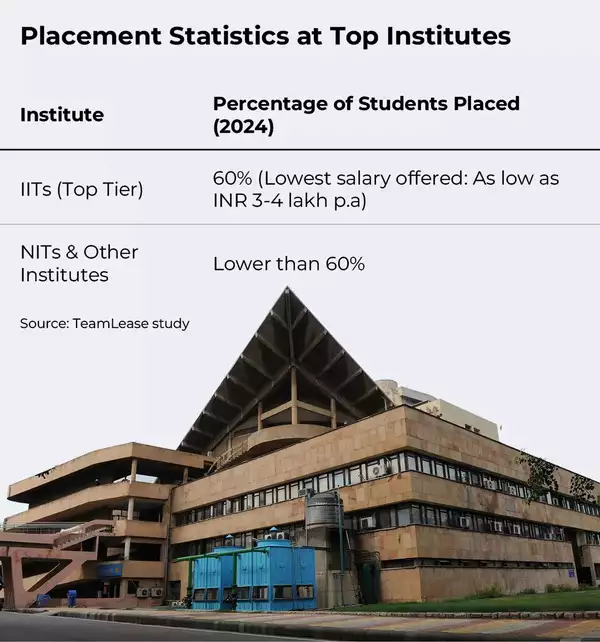
Reality check: Only 10% of engineering graduates to secure employment in 2024
The report by TeamLease has delivered a sobering statistic: only 10% of the 15 lakh engineering graduates expected to pass out this year will find jobs. This stark figure underscores a deep-rooted problem in India’s education system: A massive disconnect between academic training and industry demands, leaving millions of graduates underprepared and unemployed.
According to AR Ramesh, CEO of TeamLease Degree Apprenticeship, the calculation hinges on a combination of factors, including the employability rate, industry demands, and a significant skills gap.
“To break it down, India produces approximately 1.5 million engineering graduates each year. While roughly 60% of them actively seek employment, only 45% meet industry standards in terms of skill readiness,” says Ramesh.
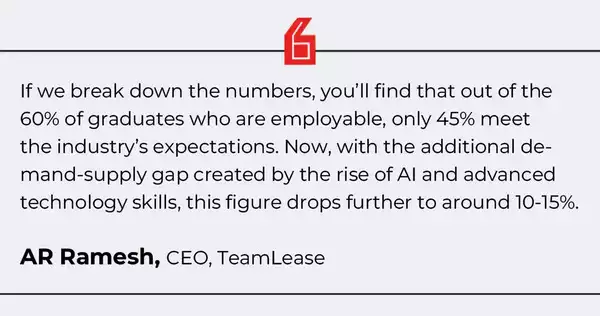
Moreover, the emergence of cutting-edge technologies like artificial intelligence (AI), electric vehicles, and semiconductors has shifted the demand toward specialised, high-tech skills, skills that many graduates lack.
Anikit Aggarwal, Founder and CEO of Unstop, a prominent talent upskilling platform for students, spoke to TOI, pointing out the growing gap between fresh graduates and industry-specific skill demands due to a lack of hands-on experience. “While students may grasp the fundamentals of AI, ML, cloud computing, and cybersecurity—key emerging skills in engineering—they lack exposure to real-world problem-solving and project-based learning,” observes Aggarwal. “The core problem lies in the disconnect between the skills taught in academic settings and the practical competencies employers seek,” he adds.
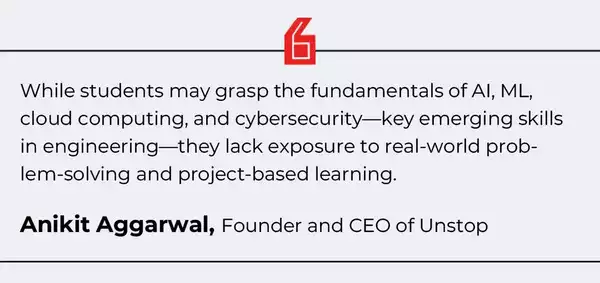
The National Employability Report for Engineering, 2019, reflects similar concerns, highlighting that 80% of Indian engineers did not possess the skills needed to thrive in the job market, despite having a degree.
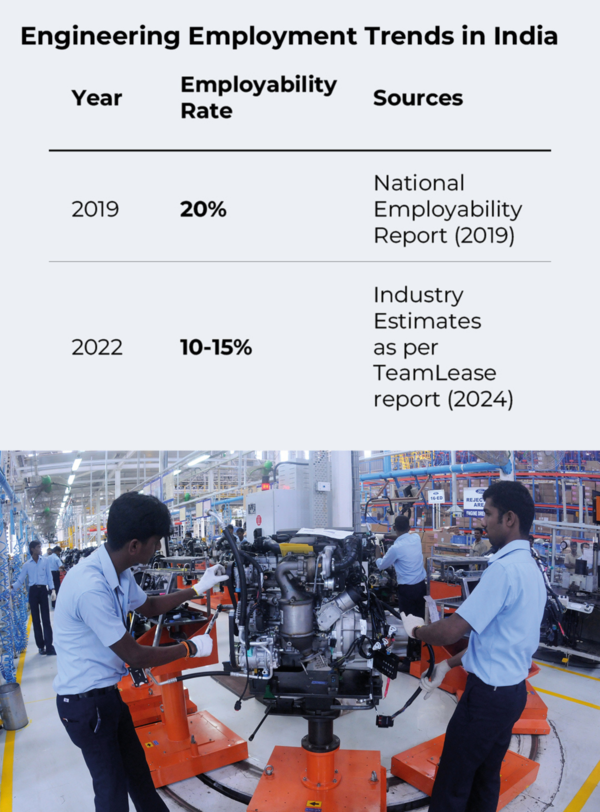
Reiterating similar thoughts, Ramesh explains that the issue isn’t necessarily the lack of jobs but rather a mismatch in expectations and skill sets. “If we break down the numbers, you’ll find that out of the 60% of graduates who are employable, only 45% meet the industry’s expectations. Now, with the additional demand-supply gap created by the rise of AI and advanced technology skills, this figure drops further to around 10-15%,” he says. Essentially, while jobs exist, they aren’t accessible to the majority of graduates due to their inability to meet the evolving demands of the tech-driven market.
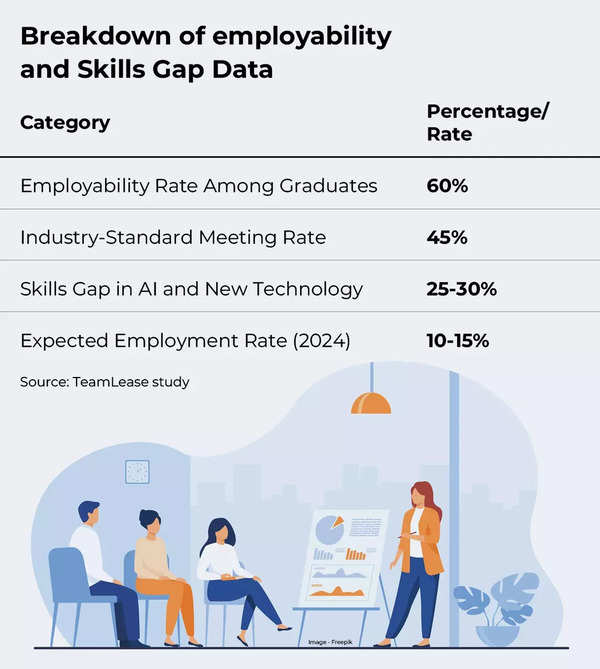
Explained: The gap between degree and skill among budding engineers
India’s technology sector continues to grow at a rapid pace, yet the gap between academic output and industry needs is widening. According to the National Association of Software and Service Companies (NASSCOM), the country will need over one million engineers skilled in AI and other advanced technologies within the next 2-3 years. Yet, the demand-supply gap for digital talent, the TeamLease report projects, is expected to widen from 25% to almost 30% by 2028. This is particularly concerning given the current oversupply of general engineering graduates and their lack of readiness to fill these niche and specialist roles.
A key challenge is the misalignment between academic curricula and industry expectations. Ramesh points out that despite the vast number of engineering colleges, the training these students receive is often outdated. “The focus has to shift towards apprenticeships and internships that blend theoretical knowledge with hands-on industry experience. This is the only way to ensure that graduates are ready for the job market,” he notes. Yet, only a fraction of students pursue such opportunities during their academic years.
The rise of new technologies, from semiconductors to AI, has also exacerbated the situation. According to a Niti Aayog report titled Electronics: Powering India’s Participation in Global Value Chains, 80% of India’s electronics engineers lack the skills needed to thrive in their field. This skills gap is not limited to one sector but is pervasive across multiple industries, causing a bottleneck in hiring even as companies ramp up recruitment in tech-focused areas.
Bridging the gap: Stronger academia-industry ties can be the saviour
Given the current scenario, the question one would ask is, what can be done? Ramesh suggests a multi-pronged approach, beginning with stronger collaborations between academia and industry to align curricula with market needs. The New Education Policy (NEP) has already initiated some of these reforms, aiming to integrate vocational training and real-world experience into academic frameworks. But the progress is slow, and in the meantime, millions of graduates are left in limbo.
TOI also spoke to Abhimanyu Sexena of ed-tech platform Scaler, specialising in upskilling techies in AI, Data Science and a host of other domains. Talking about the issue of lack of an industry-centric curriculum, he observes, “The main issue is that no one, including mainstream academic institutions, is working directly with industry leaders. We must understand the essential skills and capabilities required by these industries, design our curricula and teaching methods accordingly, and include professionals who are actively working in the field to guide students.”
When asked about what possible changes can be made in the present engineering pedagogy in India, Saxena shared that one of the key ways is to mandate industry experience through internships or apprenticeships. “At the University of Waterloo, all students must complete at least 12 months of industry internships. It is recommended that students gain practical experience by working in the industry for two years of their four-year degree,” he suggests.
For students graduating in the next few years, taking on internships or apprenticeship roles, even at lower salaries, might be the most practical way to bridge the gap between education and employability. “The idea is to gain industry knowledge and experience, which will eventually lead to better opportunities down the line,” Ramesh explains.
As the market evolves, so must India’s approach to education. Only then can the country truly harness the potential of its engineering talent, ensuring that the next generation of graduates can contribute meaningfully to the nation’s growth. Until then, the dream of engineering will remain just that, a dream for many, with only a few realising its full potential.

